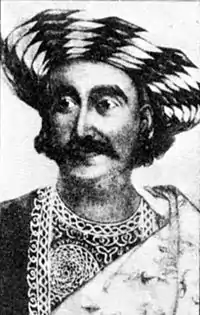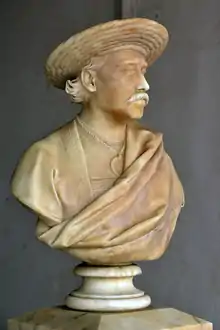Dwarkanath Tagore
Dwarkanath Tagore (Bengali: দ্বারকানাথ ঠাকুর, Darokanath Ţhakur) (1794–1846), one of the first Indian industrialists to form an enterprise with British partners[1] and entrepreneurs, was the founder of the Jorasanko branch of the Tagore family. He was the grandfather of Rabindranath Tagore.
Dwarkanath Tagore | |
|---|---|
 Dwarkanath Tagore | |
| Born | 1794 |
| Died | 1August 1846 |
| Nationality | British Indian |
| Occupation | Industrialist |
| Children | Debendranath Tagore |
Family history
The original surname of the Tagores was Kushari. They were Rarhi Brahmins and originally belonged to a village named Kush in the district named Burdwan in West Bengal. The biographer of Rabindranath Tagore, Prabhat Kumar Mukhopadhyaya wrote in the first volume of his book Rabindrajibani O Rabindra Sahitya Prabeshika that,
The Kusharis were the descendants of Deen Kushari, the son of Bhatta Narayana; Deen was granted a village named Kush (in Burdwan zilla) by Maharaja Kshitisura, he became its chief and came to be known as Kushari.[2][3][4][5]
Childhood
Dwarkanath Tagore was a descendant of Rarhiya Brahmins of the Kushari (Sandilya gotra) division. Their ancestors were called Pirali Brahmin[6][7]
On 12 December 1807, Ramlochan died leaving all his property to his adopted son Dwarkanath, who was then a minor. This property consisted of zamindari estates governed by the complicated Regulations of Permanent Settlement introduced by Lord Cornwallis in 1792. The Zamindars were the ruling authority of a certain sub-division or region under The British ruling authority in India and they (the Zamindars) had the authority to collect tax or to rule their fellow residents inside the territory of their Zamindaris on behalf of the British Government in India. Therefore, to participate in the Zamindari left by his adopted father Ramlochan Thakur as the forthcoming Zamindar, Dwarkanath left school in 1810 at the age of 16 and apprenticed himself under a renowned barrister at Calcutta Robert Cutlar Fergusson and shuttled between Calcutta and his estates at Behrampore and Cuttack.[8]

Business life
Tagore was a western-educated Bengali Brahmin and an acknowledged civic leader of Kolkata who played a pioneering role in setting up a string of commercial ventures—banking, insurance and shipping companies— in partnership with British traders. In 1828, he became the first Indian bank director. In 1829, he founded Union Bank in Calcutta. He helped found the first[1] Anglo-Indian Managing Agency (industrial organizations that ran jute mills, coal mines, tea plantations, etc.,[9]) Carr, Tagore and Company. Even earlier, Rustomjee Cowasjee, a Parsi in Calcutta, had formed an inter-racial firm but in the early 19th century, Parsis were classified as a Near Eastern community as opposed to South Asian. Tagore's company managed huge zamindari estates spread across today's West Bengal and Odisha states in India, and in Bangladesh, besides holding large stakes in new enterprises that were tapping the rich coal seams of Bengal, running tug services between Calcutta and the mouth of the river Hooghly and transplanting Chinese tea crop to the plains of Upper Assam. Carr, Tagore and Company was one of those Indian private companies engaged in the opium trade with China. Production of opium was in India and it was sold in China. When the Chinese protested, the East India Company transferred the opium trade to the proxy of certain selected Indian companies, of which this was one. In 1832 Tagore purchased the first Indian coal mine in Raniganj,[1] which eventually became the Bengal Coal Company. Very large schooners were engaged in shipments. This made Dwarkanath extremely rich, and there are legends about the extent of his wealth. "As a zamindar Dwarkanath was mercilessly efficient and businesslike, but not generous".[10]
Death

Dwarkanath Tagore died "at the peak of his fortune"[1] on the evening of 1 August 1846 at the St. George's Hotel in London during a tremendous thunderstorm with hail the size of walnuts.
In his obituary, The London Mail newspaper of 7 August wrote:
- "Descended from the highest Brahmin caste of India his family can prove a long and undoubted pedigree. But it is not on account of this nobility that we now review his life but on far better grounds. However gifted, his claims rest on a higher pedestal – he was the benefactor of his country... [T]hey testified to his merits in the encouragement of every public and private undertaking likely to benefit India."[11]
References
- Wolpert, Stanley (2009). A New History of India (8th ed.). New York, NY: Oxford UP. p. 221. ISBN 978-0-19-533756-3.
- Mukhopadhyaya, Prabhatkumar, Rabindrajibani o Rabindra Sahitya Prabeshak, 1985, Visva Bharati, p 3
- On the edges of time (New ed.) (December 1978), Tagore, Rathindranath, Greenwood Press. p. 2, ISBN 978-0313207600
- Timeless Genius, Mukherjee, Mani Shankar, Pravasi Bharatiya(May 2010), p. 89, 90
- Rabindranath Tagore : Poet And Dramatist(1948), Thompson, Edward, Oxford University Press. p. 13
- Thompson, Jr., E (1926), Rabindranath Tagore: Poet and Dramatist, Read, p. 12, ISBN 1-4067-8927-5,
The [Tagores] are Pirili Brahmans [sic]; that is, outcastes, as having supposedly eaten with Musalmans in a former day. No strictly orthodox Brahman would eat or inter-marry with them.
- Dutta, K.; Robinson, A. (1995). Rabindranath Tagore: The Myriad-Minded Man. Saint Martin's Press. pp. 17–18. ISBN 978-0-312-14030-4.
- "History of the Adi Brahmo Samaj (1906)"
- Kulke, Hermann; Rothermund, Dietmar (2004). A History of India (4th ed.). New York, NY: Routledge. p. 265. ISBN 0-415-32920-5. Retrieved 18 September 2011.
- Kling, Blair B., Partner in Empire: Dwarkanath Tagore and the Age of Enterprise in Eastern India, p. 32. University of California Press, 1976; Calcutta, 1981. ISBN 0-520-02927-5
- Kripalani, Krishna (1981). Dwarkanath Tagore, A Forgotten Pioneer: A Life. New Delhi, India: National Book Trust, India. pp. 246–7.
Further reading
- Blair B Kling, Partner in Empire: Dwarkanath Tagore and the Age of Enterprise in Eastern India, University of California Press, 1976; Calcutta, 1981. ISBN 0-520-02927-5
- NK Sinha, The Economic History of Bengal 1793–1848, III, Calcutta, 1984.
- Sengupta, Subodh Chandra and Bose, Anjali (editors), 1976/1998, Sansad Bangali Charitabhidhan (Biographical dictionary) Vol I, (in Bengali), p223. ISBN 81-85626-65-0
External links
| Wikimedia Commons has media related to Dwarkanath Tagore. |
- Works by or about Dwarkanath Tagore at Internet Archive
- Islam, Sirajul (2012). "Tagore, Prince Dwarkanath". In Islam, Sirajul; Jamal, Ahmed A. (eds.). Banglapedia: National Encyclopedia of Bangladesh (Second ed.). Asiatic Society of Bangladesh.